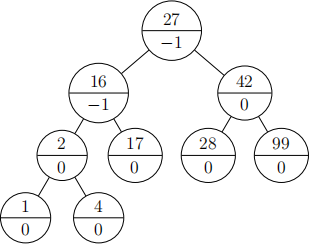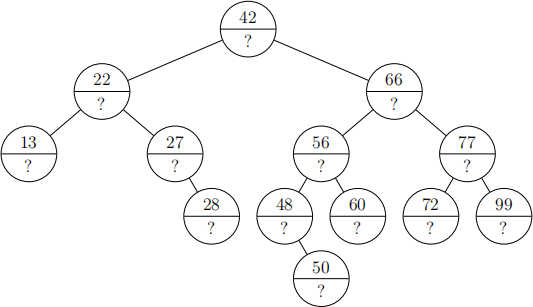关键词 > CS240
CS240 Spring 2024 Assignment 3
发布时间:2024-06-19
Hello, dear friend, you can consult us at any time if you have any questions, add WeChat: daixieit
CS240 Spring 2024
Assignment 3
Due Date: Tuesday, June 18 at 5:00pm
Problem 1 [6 marks]
Generalize quick-select (Module 3 - Slide 13) to work on two input arrays. Let the resulting algorithm be called quick-select-2arrays(A,B, k). Arrays A and B are of size n and m, respectively, and k ∈ {0, 1, ..., n + m − 1}. Algorithm quick-select-2arrays(A,B, k) should return the item that would be in C[k] if C was the array resulting from merging arrays A and B and C was sorted in non-decreasing order.
Your algorithm quick-select-2arrays(A,B, k) must be in-place, i.e. only O(1) auxiliary space is allowed per recursive function call. Briefly and informally (one or two sentences) argue that the time complexity of your algorithm is the same as of quick-select, i.e., O(v) in the average case where v is the total number of elements in A and B, i.e., v = n + m.
Hint: use the same pivot-value for partitioning both arrays.
Problem 2 [2+3+3=8]
A clever student (let’s call him Max) thinks he can avoid the worst-case behaviour of quick-sort by employing the following pivot-selection procedure. First, compute the meanM(¯) of the elements in the array. Then choose as the pivot the element x of the array, such that |x − M(¯)| is minimized, i.e., pick the element closest to the average value in the array. Everything else is the same as quick-sort. He calls the modified quick-sort algorithm MX-sort.
a) Write down the recurrence for running time T(n) of MX-sort. In doing so, assume x is placed at index i of the partitioned array. The recurrence relation may be expressed in terms of n and i.
b) Assume that the elements of the array form an arithmetic sequence (i.e., have the form a, a + k , a+2k , a+3k , . . . , a+(n − 1)k), scrambled in some order. Show that, under this distribution of array elements, MX-sort always runs in Θ(nlog n) time.
c) Unfortunately, Max’s scheme is not as clever as it looks. Give an example of an array where MX-sort achieves its worst case runtime of Θ(n2 ) and briefly explain why this example requires this time.
Problem 3 [8 marks]
Given an array A[0 . . . n − 1] of numbers, such that A[i] ≥ A[i − j] for all 0 ≤ i ≤ n − 1 and log n ≤ j ≤ i, design an algorithm to sort A in O(nlog log n) time.
Hint: Partition A into contiguous blocks of size (log n); i.e. the first (log n) elements are in the first block, the next (log n) elements are in the second block, and so on. Then, establish a connection between the elements within two blocks, which are separated by another block.
Problem 4 [2+2+4=8 marks]
Consider the problem of finding the location of a given item k in an array of n distinct integers. The following randomized algorithm selects a random index and checks whether its entry is the desired value. If it is, it returns the index; otherwise, it recursively calls itself.
Recall that random(n) returns an integer from the set of {0, 1, 2, . . . , n − 1} uniformly and at random.
find-index(A,n,k)
i = random(n)
if A[i] = k then
return i
else
return find-index(A,n,k)
end if
In your answers below, be as precise as possible. You may use order notation when appro- priate. Briefly justify your answers.
a) What is the best-case running time of find-index?
b) What is the worst-case running time of find-index?
c) Let T(n) be the expected running time of find-index. Write a recurrence relation for T(n) and then solve it.
Problem 5 [0+2+2=4 marks]
a) Practice (not worth any marks): Starting with an empty AVL tree, insert the follow- ing keys in order: 27 99 17 28 42 16 1 2 4.
You should obtain the AVL tree given in the next part.
b) Given the following AVL tree:
Note: this tree shows balance factors instead of height.

Insert the following keys in order: 8* , 22, 21, 18* .
Show the resulting AVL trees with balance factors (not height) for each node after the elements marked with star (*) are inserted.
Note: you should only show 2 trees.
c) Consider the following AVL tree:

Given the above tree, delete the following keys in order:
66, 13* , 72, 77, 56* , 42*
Show the resulting AVL trees with balance factors (not height) for each node after the elements marked with star (⋆) are deleted. If you have a choice of which element to move up, pick the inorder successor.
Note: you should only show 3 trees.
Problem 6 AVL Trees [4+6 marks]
In this question, we want to modify an AVL tree to support an operation ithSuccessor, in addition to the standard operations insert, delete, find. The operation ithSuccessor has two parameters, x and i ≥ 0, and returns the ith inorder successor of the node x. If i = 0, then the node x itself is returned. You may assume that all input is valid; i.e. the successor exists (but may not be in the subtree rooted at x).
We assume that the nodes have the following fields:
• key – the key of the node;
• left – pointer to the left child;
• right – pointer to the right child;
• balance – balance factor of the node;
• parent – pointer to the parent of the node;
• isLeft – is true if the node is a left child of its parent;
• isRight – is true if the node is a right child of its parent;
• numLeft – holds the number of nodes in the left subtree of the node;
• numRight – holds the number of nodes in the right subtree of the node.
a) Give an algorithm ithNode(x, i) which returns the ith inorder node in the subtree rooted at x. For example, suppose the subtree contains m nodes, when i = 1, the minimum element in the subtree is returned and when i = m the maximum element in the subtree is returned. You may assume that the subtree has at least i elements. Your algorithm should take worst-case O(log(m)) time. Briefly justify that your algorithm achieves this runtime.
b) Give the algorithm for ithSuccessor(x, i) if n is the number of nodes in the given AVL tree. Your algorithm should take worst-case O(log(n)) time and must use ithNode(x, i) from above. Briefly justify that your algorithm achieves this runtime.

